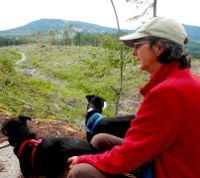Course Details
Dogs are constantly communicating with us and each other. They make requests and they tell us when they don't know what is expected of them. They communicate stress in ways that many humans interpret as being 'stubborn', 'blowing us off', or 'being disobedient,' when in fact they are very clear in their communications, telling us early on and in surprising ways... IF you know how to read them. Whether during training, in class, or in the ring, being able to read your dog is a key to building a strong bond!
In this course, we will focus on the fundamental skill of learning to observe dog (mostly stress-related) behaviors and what their function may be in context of where it's happening, with an emphasis on dog sports! This course is mostly a theory course, but you will observe dogs in photos and video and there are real life activities to try with your own dogs as well. We will experiment with the application of some dog behaviors to communicate with your dog(s) to help reduce stress. You'll also find out what other resources are available to help you continue learning dog language after the course is over.
The class is a combination of text, photos, video and questions. You are encouraged to video your own dogs in different situations (greeting other dogs, greeting people, training, new locations etc) to see what you can observe and learn about what your dog is telling you.
Topics covered:
- difference between observation and interpretation
- bias in observation
- distress vs eustress
- distance increasing behaviors
- distance decreasing behaviors
- displacement behaviors
- arousal behaviors
- rude behaviors
- context and combination behaviors
It is only when you actively practice observing that you will see what your dog and others have to say. One of the top animal trainers in the world, Bob Bailey, maintains that observing critically is one of four foundation skills you need to successfully train dogs. (The other three are timing, criteria and rate of reinforcement). Ethologists (those who study animals in their natural environment) know that it takes 1000 hours of observation to actually start getting to know your species of interest, and 10,000 hours to be an expert. Just living with your dog does not qualify as most people don't know how to observe in a useful way.
There is a video assignment if you choose to do it. You will need to be able to take footage of dogs (their own or other's dogs in training, in class, at trials or other locations) or find footage on Vimeo and Youtube to post and make detailed observations of them as homework.
Let's face it, if you are reading this, you are a dog keener (like me) and spend much of your time with your dog(s)! Wouldn't it be great to learn Dog as A Second Language? After all, they have learned our language. This is the place to get a good start on theirs!
 Instructor: Donna Hill
Instructor: Donna HillDonna Hill (she/her) has had a life long love affair with dogs and a fascination with dog behavior. She has broad practical experience in the dog world: volunteering and working in kennels and shelters, dog sitting and walking, fostering rescue dogs, teaching behavior modification privately, and...(Click here for full bio and to view Donna's upcoming courses)
